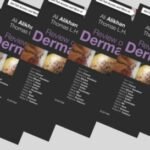The Review of Dermatology, 2nd edition, by Alikhan and Hocker, is an excellent resource for medical students, residents, and practising physicians who wish to expand their knowledge of dermatology. This comprehensive textbook covers all aspects of dermatology, from basic concepts to complex clinical scenarios.
The book is organized into 11 chapters, each covering a different aspect of dermatology. The first chapter provides a Basic Science (introduction to dermatology and covers the anatomy and physiology of the skin). The subsequent chapters cover various topics, such as Dermatopharmacology, General Dermatology, Pediatric Dermatology, Infectious Diseases, Neoplastic Dermatology, Dermatopathology, Dermatologic Surgery, Cosmetic Dermatology, Cutaneous Manifestations of Internal Disease and Metastases, & Epidemiology, amd Public Health Principles.
This book’s simple writing style is one of its advantages. The authors use simple language and avoid medical jargon whenever possible, making it accessible to readers with varying levels of medical knowledge. Additionally, the book is richly illustrated with clinical images, diagrams, and tables, which makes it easy to understand and remember key concepts.
The book also includes a wealth of useful features, such as summary boxes, which highlight the key points of each chapter and allow readers to test their knowledge and reinforce their understanding of the material. There are also numerous case studies and clinical scenarios that illustrate how the concepts covered in the book apply to real-world situations.
Overall, the Review of Dermatology, 2nd edition, is an outstanding resource for anyone seeking a comprehensive and practical guide to dermatology. Its clear and concise writing style, numerous illustrations, and functional features make it an ideal textbook for medical students, residents, and practising physicians alike.

Book Name: Review of Dermatology
Edition: Second edition
Source of PDF e-book: External source
Written by: Ali Alikhan, Thomas L.H. Hocker
Publication: Elsevier
- Basic Science
- Structure and function of the skin
- Embryology
- Wound healing
- Genetics
- Laboratory techniques and molecular biology
- Ultraviolet light
- Immunology
- Innate vs adaptive immunity
- Immunologic mediators
- Complement pathways
- Cells of significance
- Cells of significance
- Dermatopharmacology
- Antihistamines
- Retinoids
- Corticosteroids
- Immunomodulatory agents
- Oncologic agents in dermatology
- Antimicrobial agents
- Phototherapy
- Miscellaneous agents
- Drug interactions and the cytochrome P-450 system
- General Dermatology
- Papulosquamous dermatoses
- Eczematous dermatoses
- Interface dermatitis
- Blistering diseases
- Connective tissue diseases (CTDs) and sclerosing dermopathies
- Granulomatous/histiocytic disorders
- Monoclonal gammopathies of dermatologic interest
- Xanthomas
- Urticaria and angioedema
- Neutrophilic dermatoses
- Eosinophilic disorders
- Figurate erythemas
- Follicular and eccrine/apocrine disorders
- Drug reactions
- Photodermatoses and other physical dermatoses
- Amyloidoses
- Neurodermatology and psychodermatology
- Palmoplantar keratodermas
- Nutritional disorders in dermatology
- Depositional and calcification disorders not discussed elsewhere
- Ulcers
- Vasculitides, vasculopathy, and other vascular disorders
- Panniculitides and lipodystrophies
- Dermatoses of pregnancy
- Hair, nail, and mucosal disorders
- Pigmentary disorders
- Pediatric Dermatology
- Neonatal dermatology
- Viral exanthems and select infectious disorders of childhood
- Inherited pigmentary disorders
- Epidermolysis bullosa
- Tumour syndromes
- Vascular tumours, malformations, and related vascular disorders
- Disorders of hair and nails
- Inherited metabolic and nutritional disorders
- Inherited metabolic and nutritional disorders
- Autoinflammatory disorders (periodic fever syndromes)
- Neurocutaneous syndromes
- Premature ageing syndromes and DNA repair disorders
- Primary immunodeficiency disorders with cutaneous manifestations
- Disorders of cornification
- Miscellaneous pediatric dermatologic disorders
- Infectious Diseases
- Viral diseases
- HIV/AIDS dermatology
- Bacterial infections
- Fungal diseases
- Parasites and other creatures
- Neoplastic Dermatology
- Keratinocytic neoplasms
- Cysts
- Melanocytic neoplasms
- Adnexal neoplasms and hamartomas
- Hair follicle neoplasms/hamartomas
- Sebaceous proliferations
- Neural neoplasms
- Smooth muscle neoplasms
- Hematolymphoid neoplasms
- Fibrohistiocytic neoplasms
- Vascular proliferation
- Neoplasms of adipocytic lineage
- Dermoscopy
- Dermatopathology
- Essential concepts in dermatopathology
- High-yield dermatopathology diagnoses at a glance
- High-yield dermatopathology differential diagnoses
- Dermatologic Surgery
- Dermatologic Surgery
- Surgical instruments and needles
- Suture techniques
- Wound closure materials
- Local anaesthetics and perioperative pain control
- Antisepsis – garbs and preps
- Electrical hemostasis
- Cryosurgery
- Excisions
- Mohs surgery
- Flaps
- Grafts
- Surgical complications and measures to avoid them
- Scar improvement
- Nail surgery
- Cosmetic Dermatology
- Lasers
- Botulinum toxin
- Dermal fillers
- Liposuction and fat reduction
- Sclerotherapy
- Cosmeceuticals and nutraceuticals
- Hair transplantation
- Chemical peels
- Cutaneous Manifestations of Internal Disease and Metastases
- Cardiovascular/cardiopulmonary
- Endocrine
- Gastroenterology
- Neurology
- Renal
- Paraneoplastic syndromes
- Epidemiology, Statistics, Study Design, and Public Health Principles
- Statistical definitions
- Epidemiologic principles
- Types of studies and their limitations
- Types of bias
- Maintenance of certification for the American Board of Dermatology
- Billing
- Index